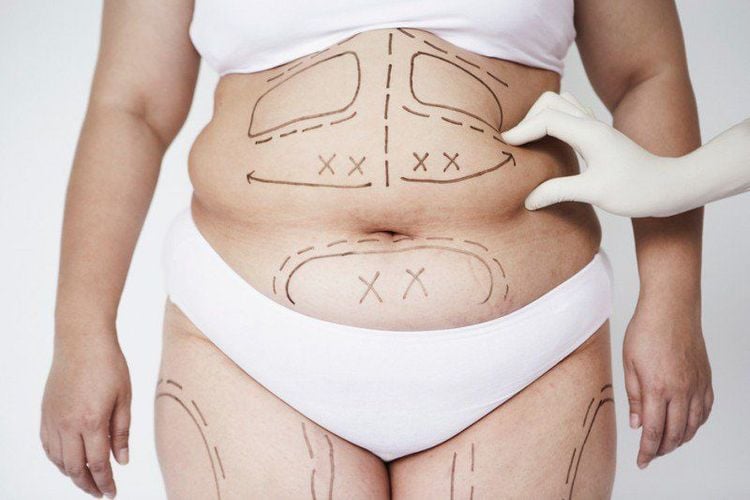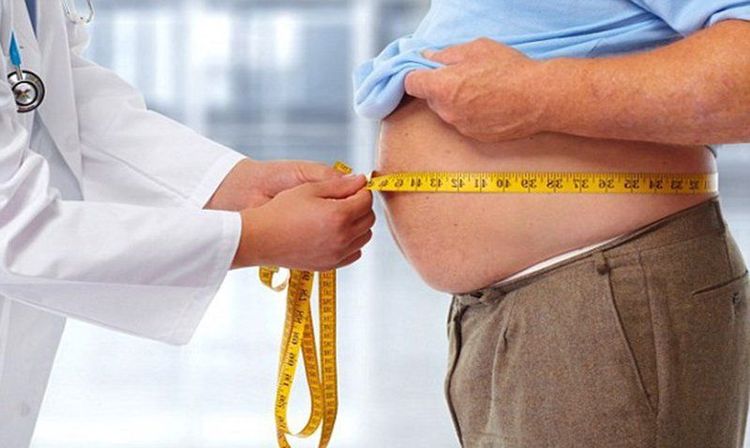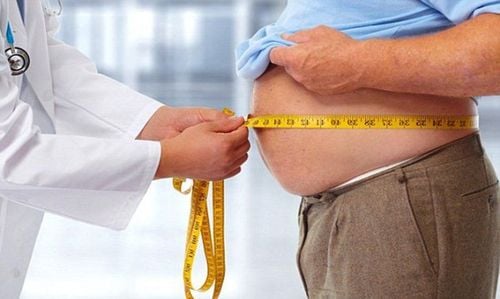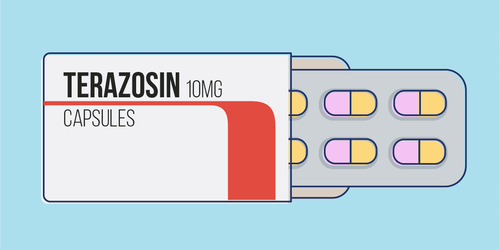This is an automatically translated article.
Currently, BMI (body mass index) is the most common way to determine if a person is at risk for weight-related health problems, but it may not be the most accurate. Now, for some serious diseases, the location on the body where more fat is accumulated is more significant than overall weight. In particular, waist circumference is considered an important measurement of the body's risk of health problems.
1.Fat storage sites and apple and pear body types Each of us tends to store more fat in certain areas of the body. Obesity tends to accumulate more fat in the waist area than in other areas of the body, leading to the apple-shaped body shape, which is common in men.
If you look closely at the shape of a pear, you can see that there is a narrow top and a large bulge at the bottom. People with a pear shape have a similar appearance. These people have relatively slim upper bodies, moderate waistlines, and most of their body weight is concentrated in the hips, buttocks, and thighs. The pear-shaped body has many health benefits. Pear-shaped people store most of their fat in the lower body, so they have a lower risk of cardiovascular disease and type 2 diabetes than apple-shaped people.
People with an apple shape carry weight in the abdomen and waist. These subjects may have slim thighs, but large waists because they store a lot of fat there. Apple-shaped individuals are at increased risk for metabolic syndrome, which leads to a host of metabolic problems including high triglyceride levels and high blood pressure that increase the risk of heart disease and type 2 diabetes. This can also happen when your body weight or BMI is within normal limits. That's because apple-shaped bodies are high in visceral belly fat, the type that increases the risk of heart disease. An apple shape is basically an indication for visceral fat that is not good for the body.
Women often accumulate fat around the hips and thighs, resulting in a "Pear-shaped" body type (although an apple shape can also be developed). This is mainly due to the effect of estrogen on fat distribution. During the reproductive years, women have high estrogen levels, fat will be transferred to the lower body, and when estrogen levels decrease, fat storage will shift to the middle of the body. A study of 200 volunteers that determined the location of body fat distribution in men and women by DXA scans found that the women in the study had a higher percentage of body fat than men and a higher body mass. body less than men. Women also have more subcutaneous fat, while men have a higher percentage of visceral fat or abnormally distributed fat. This is due to more fat accumulation in the male organs such as the pelvic cavity, liver and muscles.

Ở nữ giới có tỷ lệ mỡ cơ thể cao hơn nam giới và khối lượng cơ thể ít hơn so với nam giới
2. How does a large waist size increase the risk of disease? More than 60 years ago, a French doctor named Jean Vague observed that people with large waists had a higher risk of cardiovascular disease and death than those with slim waists or high body weight. mainly concentrated around the hips and thighs (not on the abdomen). Decades later, long-term follow-up studies showed that "belly fat" was strongly associated with an increased risk of type 2 diabetes, cardiovascular disease, and death, even when body mass index (BMI) was low. body mass index (BMI) within normal limits.
3. Limitations of Body Mass Index BMI BMI is an index that determines the degree of correlation between weight and height, used by most dieters and health professionals to appropriate weight assessment. However, BMI does not include body composition factors such as fat percentage or muscle mass, which are seen as factors that also contribute significantly to current health status.
For example, a bodybuilder would be “obese” if classified based on BMI because large muscle mass increases weight. In contrast, people who were disproportionate and had a lot of mid-body fat were classified as normal weight. But these people will be at higher risk of health problems.
These limitations have led to today, many experts rating waist circumference as a better indicator of overall health.
4. Why does belly fat increase the risk of disease? Belly fat represents an excess of body fat. Besides, fat is not only accumulated in the waist area, but also in internal organs such as around the liver and other organs in the abdomen, known as visceral fat.
Studies show that waist size is correlated with visceral fat levels and with insulin resistance. Increased waist size increases the amount of visceral fat. Visceral fat is also strongly linked to inflammation, which is a cause of chronic health problems. Visceral adipose tissue releases inflammatory chemicals called inflammatory cytokines. Inflammation is a driver of health problems, so the more chronic inflammation is reduced, the better for the body's health.

Béo bụng có thể là dấu hiệu cảnh báo nguy cơ mắc bệnh của cơ thể
This excess fat can release fatty acids, inflammatory agents and hormones that eventually lead to increased LDL cholesterol, triglycerides (which are the bad cholesterol in the body, increased blood sugar and higher blood pressure.
5. How much waist is considered dangerous?There are two most common ways to determine "belly fat" (apple shape) is to measure the waist circumference and calculate the ratio of waist size to hip size, also known as waist-to-hip ratio.Some organizations have defined cut-offs for abdominal obesity using one or two measurements, with different cut-offs for men and women (see table).
In people who are not overweight, having a large waistline may mean that these people have a higher risk of health problems than someone with a slim waist.
The Nurses' Health Study, one of the largest and longest-running studies to date that has measured abdominal obesity, looked at the relationship between waist size and mortality from cardiovascular disease, cancer or any cause in middle-aged women. At the start of the study, all 44,000 study volunteers were healthy, and they all had their waist and hip sizes measured.
After 16 years, research results show that women with a waist size greater than 89 (35 inches) are twice as likely to die from cardiovascular disease as women compared to women with a waist size. waist size less than 71cm (under 28 inches).
Women in the large waist group (> 89cm) had a higher risk of dying from cancer or any cause, compared with women with a small waist (< 71cm). Risk goes up by one notch if waist circumference increases every 3cm (about 1 inch)
Research shows that even women of normal weight, BMI less than 25 have a higher risk, if weight The body is concentrated in the waist area. Normal-weight women with a waist circumference (>89cm) or more are three times more likely to die from cardiovascular disease than normal-weight women with a waist circumference less than 89cm.
The Women's Health study in Shanghai found a similar relationship between belly fat and risk of all-cause mortality in women of normal weight.
6. Waist circumference or waist-hip ratio? Scientists have long debated whether determining belly fat as a predictor of health risk based on waist size or waist-to-hip ratio, which is better. Research to date has been controversial. But recent evidence from multiple studies suggests that both methods do a good job of predicting health risks. In 2007, a meta-analysis of 15 prospective cohort studies found a ratio between Waist-hip and waist circumference were both associated with CVD risk and did not differ in predictability of CVD risk.

Chỉ số chu vi vòng eo có liên quan đến rủi ro mắc bệnh tim mạch
Other researchers have also found that waist circumference, waist-to-hip ratio and BMI are strong predictors of type 2 diabetes.
Nurse' Health study also found circumference Waist circumference and waist-to-hip ratio were equally effective in predicting subjects at risk of dying from heart disease, cancer, or any other cause.
In fact, it is easier to measure and interpret waist circumference than measuring both waist and hip circumference. This makes waist circumference a better choice for many regional medical conditions.
Periodic health check-ups help to detect diseases early, so that there are treatment plans for optimal results. Currently, Vinmec International General Hospital has general health checkup packages suitable for each age, gender and individual needs of customers with a reasonable price policy.
Results of the patient's examination will be returned to the home. After receiving the results of the general health examination, if you detect diseases that require intensive examination and treatment, you can use services from other specialties at the Hospital with quality treatment and services. outstanding customer service.
Please dial HOTLINE for more information or register for an appointment HERE. Download MyVinmec app to make appointments faster and to manage your bookings easily.













